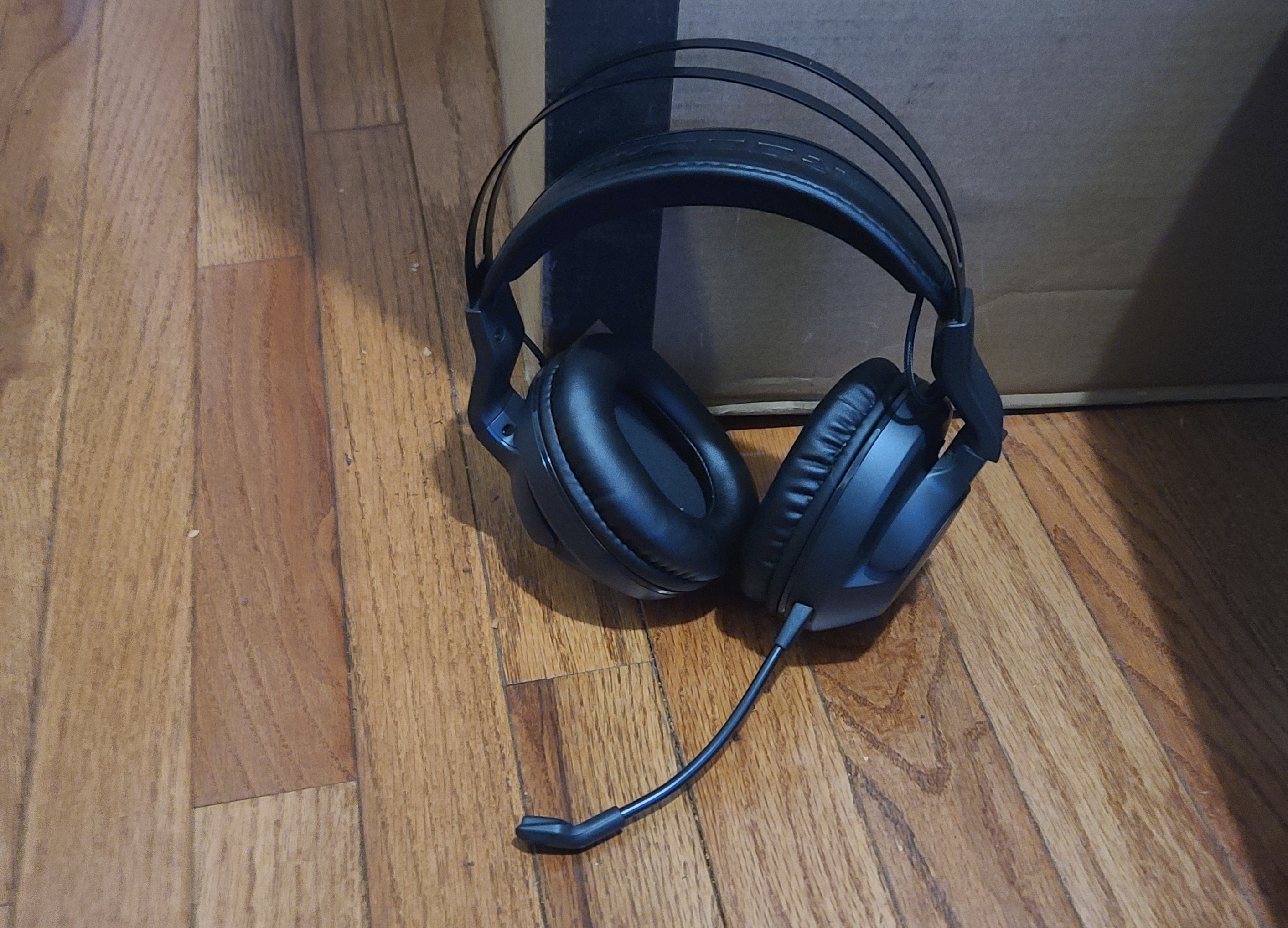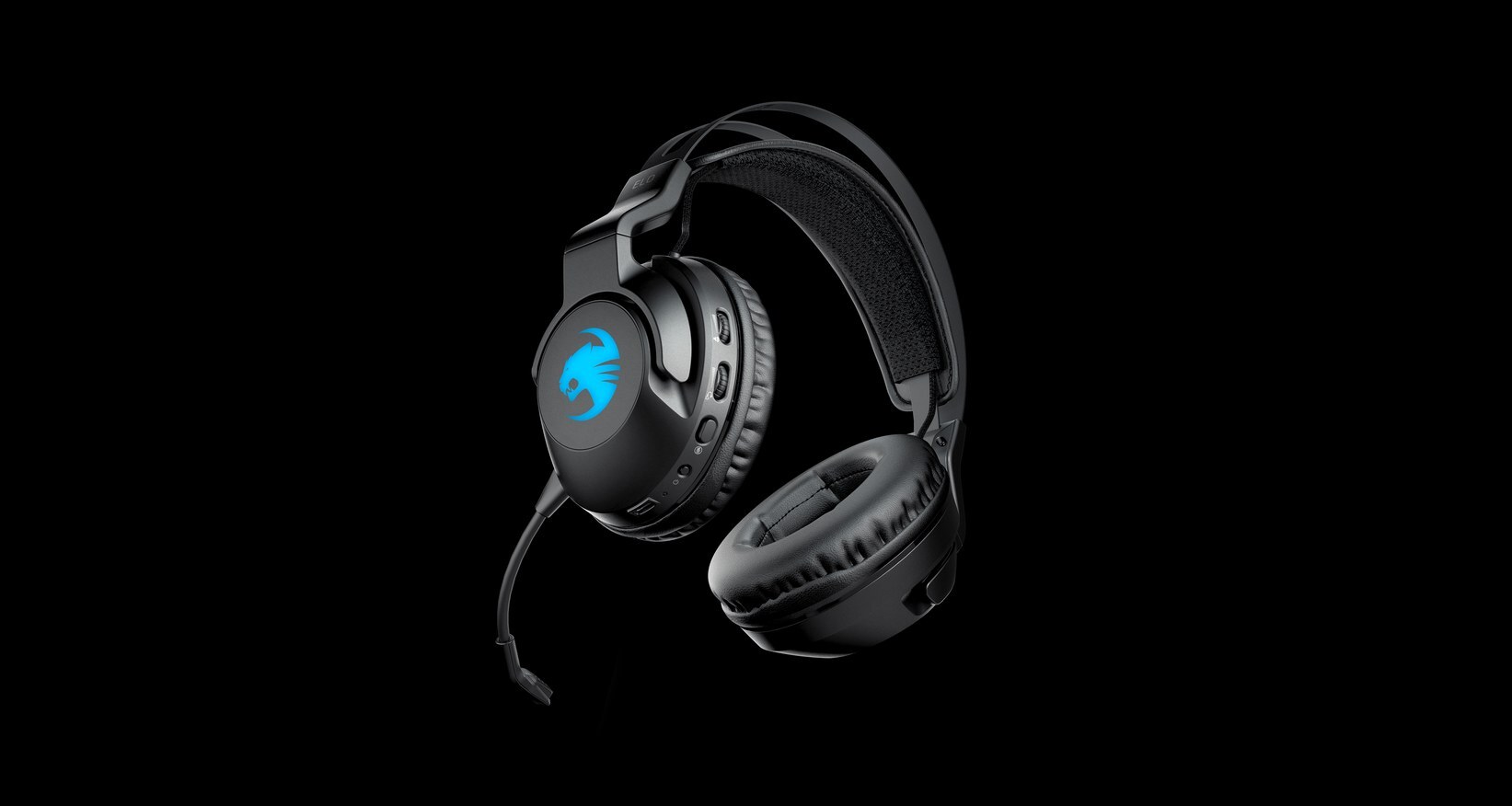Tom's Hardware Verdict
Roccat has produced a compelling, budget-friendly wireless headset in the Elo 7.1 Air. It’s well designed, solidly built and packed with features that typically command a higher asking price. However, you’ll have a hard time determining how much battery life it has left.
Pros
- +
+ Intuitive control layout
- +
+ Well-tuned, balanced mic
- +
+ Self adjusting headband actually works well
- +
+ Lots of audio tweaking options
Cons
- -
Audio leakage at high volumes
- -
Software’s battery reading is imprecise
Why you can trust Tom's Hardware
PC gamers will find a lot to love about the Roccat Elo 7.1 Air and don’t have to spend a huge premium to obtain it. At $99.99 as of this writing, the Elo 7.1 Air is cheaper than a lot of wireless gaming headsets. Plus, it offers comfort, solid audio with the option for virtual 7.1 surround sound and enough bonus features to spare.
In its fight to be the best gaming headset, these cans opt for a wireless connection, letting you cut the cord and simply plug in a USB Type-A dongle. (Sorry, console gamers; this is PC-only). But although dropping the cable is convenient, being limited in how far you can move from your PC and unsure of exactly how much battery life remains are not.
Roccat Elo 7.1 Air Specifications
| Driver Type | 50mm Neodymium |
| Impedance | 32 Ohms |
| Frequency Response | 20-20,000 Hz |
| Microphone Type | Unidirectional, noise-cancelling, detachable |
| Connectivity Options | USB Type-A dongle, USB Type-A cable |
| Cables | 6-foot (2m) USB-C to USB Type-A cable |
| Weight | With mic: 0.8 pounds (345g) |
| Lighting | 1x RGB zone |
| Software | Roccat Swarm |
Design and Comfort
The Roccat Elo 7.1 Air is a sleek, matte-black beast, from the top of its headband all the way down to the metal forks holding its earcups. Apart from the RGB-illuminated Roccat name and logo adorning the headset’s earcups, the Elo 7.1 Air sports a relatively understated look for a gaming headset, allowing it to camouflage its gaming pedigree and looks just as at home in a more professional environment as it does in a gaming setup.
There are a number of subtle, thoughtful touches to the Elo 7.1 Air’s overall design that make it very pleasant to use for long gaming sessions. The earcups swivel, allowing for comfortable neck wear when not in use. Controls are conveniently located (on/off, microphone and headset volume and microphone on/off ) on the left earcup. The mic mute and power buttons differ greatly in size, so they are easy to locate by feel alone, and the individual volume wheels for the cans and the mic are satisfyingly tactile. Thanks to the headset’s simple, intuitive layout, my fingers never ended up pressing the wrong button.
The Elo 7.1 Air weighs in at 0.8 pounds with the microphone attached, making it a tad on the girthy side. For comparison, the similarly priced SteelSeries Arctis 1 Wireless is 0.6 pounds. But the Elo 7.1 Air isn’t a dramatic outlier: the wireless Corsair HS70 Bluetooth and Razer Blackshark V2 Pro are only slightly lighter at 0.7 pounds each.
Most importantly, the Elo 7.1 Air’s weight did not result in any discomfort during long play sessions. The headset’s leatherette headband offers ample cushioning. Roccat opted for a self-adjusting headband, rather than allowing gamers to manually tweak how the Elo 7.1 Air sits on their head, and I’m pleased to report that Roccat got it right. The headset clamps down tight with minimal wobble and stays in place without any need for further adjustment. I usually detest self-adjusting headbands because they never seem to fit my rather large noggin without significant slippage, so it’s wonderful to finally experience one that works as advertised.
Adding to the Elo 7.1 Air’s ability to stay rocking for the long haul, the memory foam padded earcups are comfortably tight with just the right amount of depth to avoid crushing ears against the drivers. They also include Turtle Beach’s so-called ProSpecs Glasses Relief System, which features softer foam in the area where glasses would rest for less pressure.
Get Tom's Hardware's best news and in-depth reviews, straight to your inbox.
If you want to change the look of the RGB logos on the earcups, you’ll need Roccat’s Swarm software (more on that in the dedicated section below). Note that there’s only 1 RGB zone, so the two earcup’s settings aren’t individually addressable. You can choose between Color Cycle, Fully Lit, Heartbeat, Breathing, Blinking or Roccat’s Aimo Intelligent Lighting, which is supposed to react to how you use the headset and improve the more you use it. This sounds cool in theory, but I didn't notice it responding to gameplay or other actions. I even played with the headset sitting on my desk to see if I could notice gameplay-specific lighting reactions, and while there were some cool effects, it didn’t seem obviously triggered by any audio cue. It’s possible Aimo could improve with more use, but experience with other peripherals tells us it takes a lot of use to fill up Aimo’s capability meter to 100%.
In general though, each RGB effect looks striking, if a bit too bright even at lower brightness settings. You can also pick your speed preference (aside from AIMO and Fully Lit, which only allow brightness controls). As cool as AIMO is, there is little to recommend about using it on a headset where you will not be seeing the effect during gameplay -- unless, you prefer to look at your headset instead of your monitor while gaming. We won’t judge you (much).
Audio Performance
Roccat equips the Elo 7.1 Air with 50mm neodymium drivers with a frequency response of 20-20,000 Hz. Those drivers are a little bigger than the 40mm drivers in the Arctis 1 Wireless, which has the same frequency response. And even some pricer wireless headsets, like the $130 Logitech G733 Lightspeed (40mm, 20,-20,000 Hz) offer lesser specs than our review focus; although, you’ll get beefier spes front he Razer Blackshark V2 Pro and HyperX Cloud II Wireless. Still, the Elo 7.1 Air has good specs for the price and should cover the full frequency of what human ears can hear. Ultimate audio performance is about more than specs though.
And the Elo 7.1 Air ultimately delivers exceptional audio. The booming bass we’ve all come to know and love from gaming headsets is well represented here but thankfully doesn’t interfere with clarity across the frequency range. Mids and highs are crisp and clear, making the Elo 7.1 Air well-suited for music, movies and gaming.
What we’re all here for, however, is gaming performance, and the Elo 7.1 Air fared exceptionally well in this category. With virtual 7.1 surround sound on, positional audio cues were readily apparent in DOOM Eternal and CS:GO, as well as in slower paced titles like the Dark Souls series dripped with atmosphere. Even in frantic firefights with explosions aplenty, these cans didn’t distort the overall mix. Gaming with the ELO 7.1 Air is still a good experience in stereo mode, but the virtual 7.1 brings out a level of spatial detail that you miss out on in stereo.
The Elo 7.1 Air also makes use of Turtle Beach’s “Superhuman Hearing” feature (Turtle Beach acquired Roccat in 2019), which is a bit of a mixed bag in my experience. Superhuman Hearing amplifies more subtle sound effects like footsteps in both stereo and virtual 7.1 mode, and this can certainly be useful in competitive titles. But it does so at the expense of the overall sound mix. Everything simply sounded too compressed for my liking with Superhuman Hearing turned on. Those with less ears meticulous though, may opt for the potential gaming advantage. But I felt like I wasn’t hearing the game as the developers intended.
When I tested the headset in stereo mode, music really popped, whether headbanging to Meshuggah or relaxing to Marvin Gaye. Movies, meanwhile, were a treat with virtual 7.1 surround sound on. The horrors of Omaha Beach in Saving Private Ryan felt very real. Likewise, the epic battles of The Lord of the RIngs: Return of the King were extremely convincing.
The Elo 7.1 Air is loud without being earsplitting (whether 7.1 was on or off), but these cans are not well-isolated. While outside noise isn’t allowed in, there is significant spillage of audio into the outside world when listening at 80-100% volume. This is perfectly fine with your gaming setup at home, but it’s not ideal in an office setting or out in public, where the excess sound pouring out of your headset will likely annoy those near you.
There was no noticeable signal degradation or audio artifacting when using the Elo 7.1 Air’s 2.4 GHz dongle. Sound remained crisp and clear. However, the advertised 30-foot range didn’t prove to be accurate in my home. At approximately 18 feet from my desktop I started to notice signal degradation and breakup. When I reached a distance of 25 feet, I lost signal completely, and the headset shut itself off. As with all wireless headsets, your environment will make all the difference in getting the best reception at range, so your experience may vary. An open concept space will no doubt fare far better than my railroad-style apartment in Queens.
Of course, you also have the option to use the cable (USB-C to USB-A) for a wired connection or to use the cans while it’s charging.
Microphone
The Elo 7.1 Air’s mic is exceptionally well-tuned, avoiding the nasally top end found in many gaming headset mics. While some background noise, such as clicky mechanical keyboards, can be picked up, it is well within acceptable noise levels, even without noise cancelation turned on via software. With noise cancelation enabled, there was a notable improvement, and you can easily adjust sensitivity via software. I found dropping the mic’s sensitivity is necessary, as the default level is a bit too high gain and can distort occasionally. The addition of a windscreen on the mic would have been nice, as there is noticeable pop with hard consonants.
Battery Life
Roccat claims the Elo 7.1 Air has a 24-hour battery life, and my testing confirmed this to be true. In normal use cases, this amounts to roughly a week before the headset will need to be charged.
But Roccat’s Swarm software (more on it below) doesn’t provide exact battery meter readings. The battery life indicator only decreases in 25% increments, meaning you’re never sure what exact level of charge you’re at. While this is less of a problem than it’d be on headsets with shorter battery life, it’s still strange to see the indicator jump from 100% to 75% with no warning. Hopefully, a software update will provide more accurate data on the state of the Elo 7.1’s charge.
The Elo 7.1 Air can be fully charged from a dead battery in as little as 90 minutes, so, thankfully, downtime between marathon sessions is minimal.
Features and Software
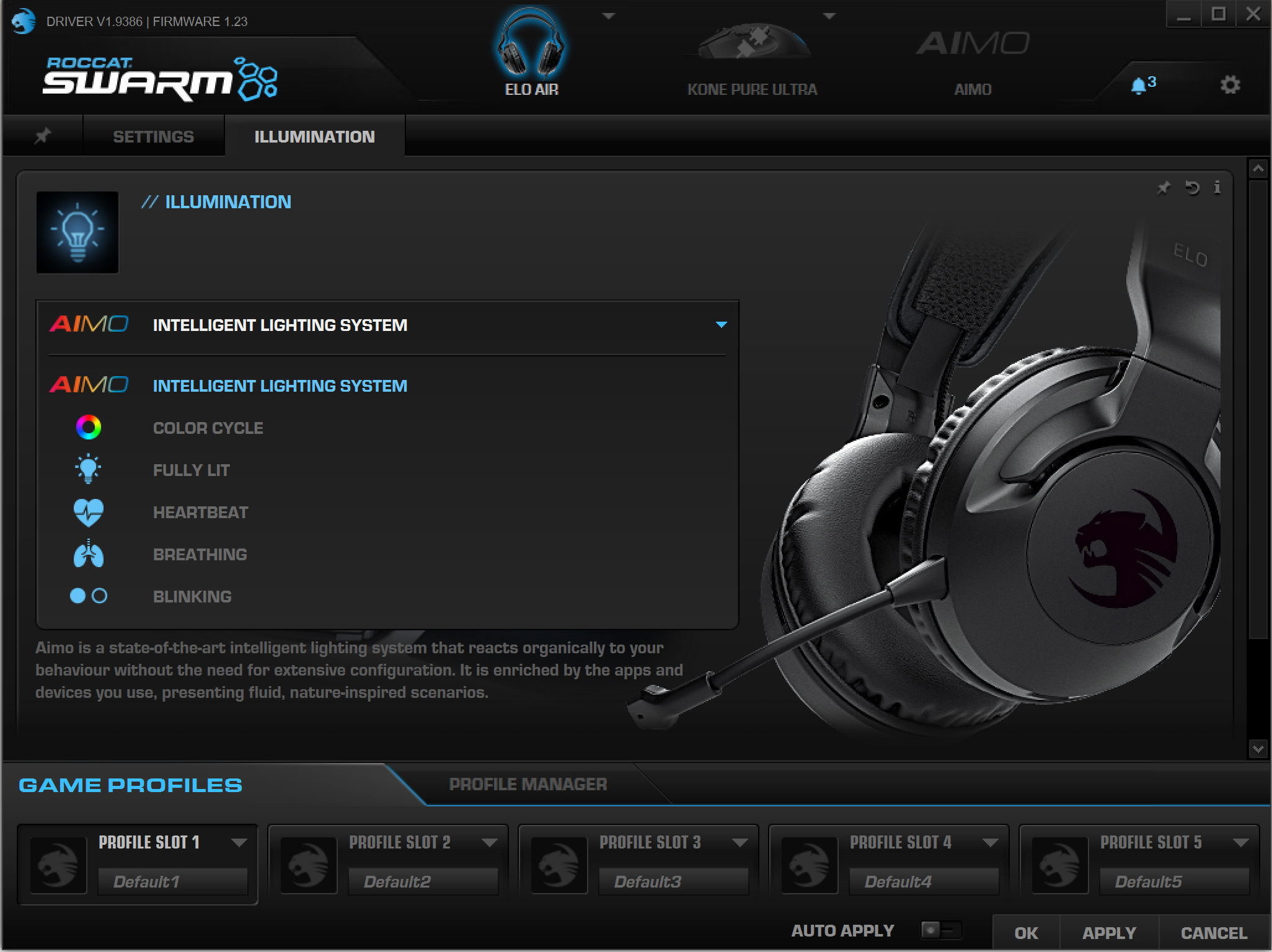
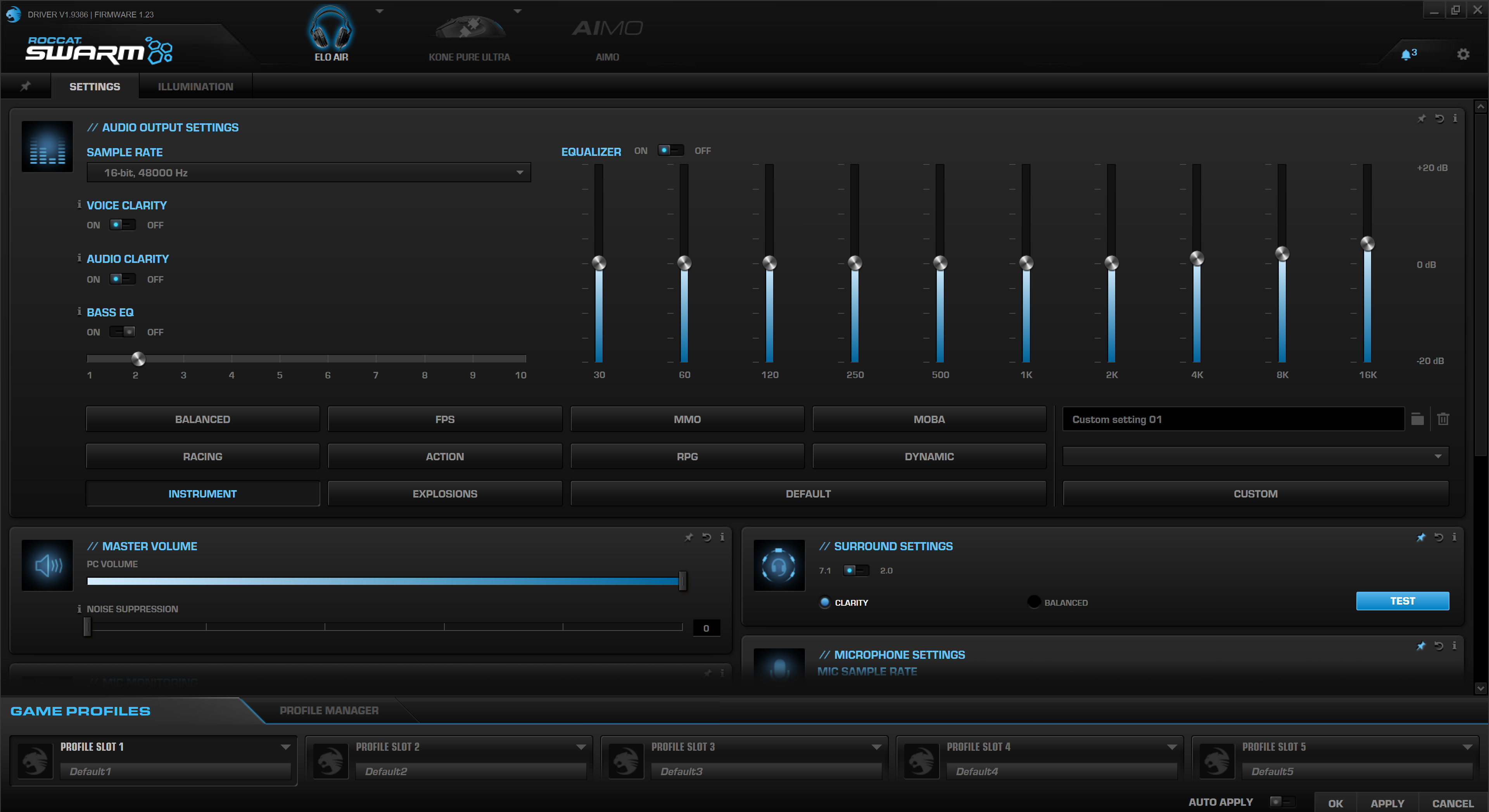
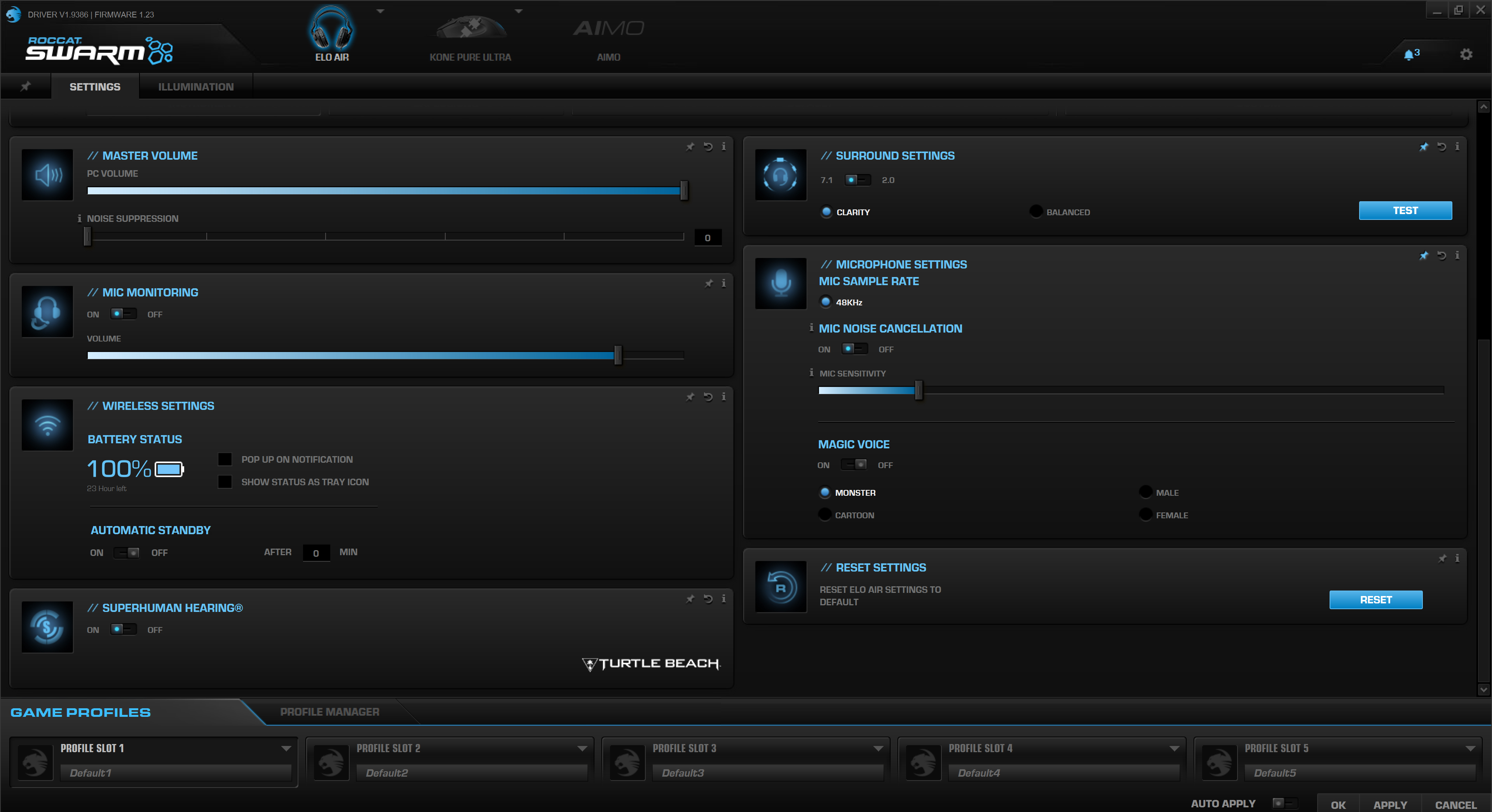
The Roccat Elo 7.1 Air has ample audio tweaking options available via the Roccat Swarm software, including a number of different EQ settings (Balanced, FPS, MMO, MOBA, Racing, Action, RPG, Dynamic, Instrument, Explosion and Default). In a movemore rare for gaming headsets, especially in this price range, you can store up to five profiles in onboard memory, making for easy switching to preferred settings by individual games or genre.
Each EQ curve is tailored to its specified gaming genre, with the Racing, Explosions and FPS presets offering a significant bass boost and the others a more mid-frequency focused experience. The Balanced and Instrument presets were best for music with their flatter curve, and Dynamic was well-suited for movies with its high and low frequencies boosted. The Default preset was a little too ‘scooped’ (mid frequency range de-emphasized) for my liking.
Swarm lets you play with the bass frequency EQ, but I mostly left that alone because it disables the ability to play with the full frequency range via the 10-band graphic EQ.
You can tweak a large number of other parameters with Swarm, including toggling virtual 7.1 surround sound, Magic Voice (voice masking), mic noise cancelation and Superhuman Hearing. The app also lets you play with the clarity of voice and audio and adjust mic sensitivity and the bass frequency EQ.
The Swarm UI is very clean and intuitive, free of clutter and with all functionality clearly labeled.
Bottom Line
The Roccat Elo 7.1 Air manages to punch above its weight class in all of the categories that matter, providing great value for your hard-earned cash.
The virtual 7.1 surround sounds huge and crisp, even with its wireless connection. The self-adjusting headband manages to be comfortable instead of an exercise in futility. And the mic is a step above what is commonly found on many gaming headsets
There are a few small issues that prevent the Elo 7.1 Air from achieving perfection, most notably the lack of a truly accurate battery level monitor. The inclusion of Turtle Beach’s Superhuman Hearing tech will be hit or miss for most as well. But these issues are relatively small when all of its advantages are considered.
Coming in at $99.99, the Elo 7.1 Air is worth a look. It’s also a good option over the SteelSeries Arctis 1 Wireless for the same price if you want virtual 7.1 surround sound more than you want additional connectivity options. Small quibbles aside, affordable wireless gaming headsets don’t get much better.

Nate Rand is a freelance reviewer for Tom's Hardware US, covering gaming headsets, keyboards, mice, and microphones.
